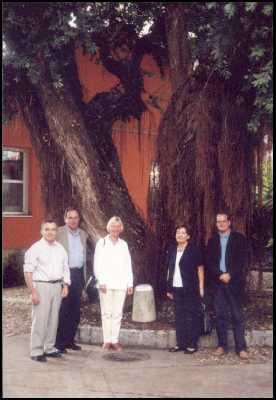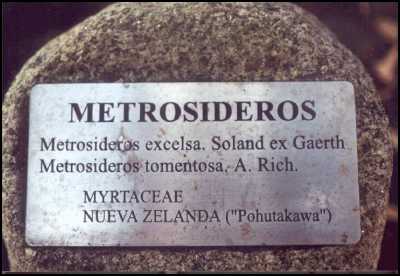Famous Tree Sparks Debate On Discovery Of NZ
Famous Tree Sparks Debate On Discovery Of New Zealand


A pohutukawa tree at 'the end of the world' has stirred up debate on whether the Spanish were the first Europeans to reach New Zealand, ahead of the Dutch and the British.
The giant pohutukawa is a big attraction in the Spanish north-west coastal city of La Corunna, capital of the province of Galicia. This province was thought until the time of Columbus to be at the end of the world.
La Corunna's mayor has chosen the tree as the city's floral emblem, and many locals believe it to be 400 to 500 years old. However, because the tree is a New Zealand native, this could mean that the Spanish sailed to New Zealand before Captain James Cook in 1769, or Abel Tasman in 1642. A Spanish helmet found in Wellington harbour about 1880 is one clue that the Spanish were here earlier.
Landcare Research botanist Dr Warwick Harris has recently returned to New Zealand after a tour that included an invitation to talk about New Zealand native plants in La Corunna. He caused a flurry of local media coverage when he stated his belief that the tree could not be more than 200 years old.
"No-one knows exactly how the tree got to La Corunna, and it has not been scientifically aged.
"However, I have the romantic idea that it was brought into Spain by the British during the Napoleonic wars and can be linked to the heroic story of Sir John Moore."
Moore took a small British army into Spain in 1808 to check the French invasion, but was forced t o make a strategic retreat over mountains, pursued by Bonaparte himself and a huge army. Neverthele ss, the British mission saved Spain from full occupation by the French. Moore eventually led his me n more than 400 kilometres to La Corunna where British ships were waiting, but in the last phase of the evacuation his arm was blown off by a French cannon. He saw the end of the battle and died, a nd his hurried burial was immortalised in a famous poem by Sir Charles Wolfe.
Dr Harris says the history relating to Moore indicates it is likely there was a British garrison in La Corunna in the early 1800s. "At some stage the British must have recovered Moore's body, and laid him in a tomb in what is now the Garden of San Carlos, created in 1834. Most likely there was a British involvement in the creation of the garden, and it is a romantic thought that the pohutuk awa came to La Corunna at that time.
"We know that Captain Cook brought back plants from his first voyage to New Zealand, and within ten years there was commerce in those plants in England. We don't know about pohutukawa specifically , but we do know that the British were largely responsible for introducing New Zealand plants to Europe".
Links to Christchurch Dr Harris says the mayor of La Corunna, Dr Francisco Vasquez, is interested in forming a sister relationship with Christchurch, its antipodal city.
"If you drilled a whole through the earth from Christchurch, the nearest city you'd come out at is La Corunna.
"So the famous pohutukawa is about as far away from home as it could possibly get."
Pohutukawa quite at home in Spain While pohutukawa struggle in some parts of New Zealand, Dr Harris says they thrive in the coastal regions of Galicia.
"Pohutukawa there are not subjected to possums. The frost-free conditions in coastal areas suit them nicely. New Zealand cabbage trees are also common in La Corunna, as are flaxes.
"There's actually some concern that New Zealand plants might become invasive, as have Australian Eucalypts, which create a fire risk.
"But as Galicia regularly has very dry summers, our natives probably wouldn't spread from where they are planted to survive in the wild".


 NZ Trucking Association: TruckSafe New Zealand Launches | A Game-Changer For Heavy Vehicle Safety And Compliance
NZ Trucking Association: TruckSafe New Zealand Launches | A Game-Changer For Heavy Vehicle Safety And Compliance Gaurav Mittal, IMI: How Can We Balance AI’s Potential And Ethical Challenges?
Gaurav Mittal, IMI: How Can We Balance AI’s Potential And Ethical Challenges? Science Media Centre: Several US-based Environmental Science Databases To Be Taken Down – Expert Reaction
Science Media Centre: Several US-based Environmental Science Databases To Be Taken Down – Expert Reaction Consumer NZ: Despite Low Confidence In Government Efforts, People Want Urgent Action To Lower Grocery Bills
Consumer NZ: Despite Low Confidence In Government Efforts, People Want Urgent Action To Lower Grocery Bills NZ Banking Association: Banks Step Up Customer Scam Protections And Compensation
NZ Banking Association: Banks Step Up Customer Scam Protections And Compensation The Reserve Bank of New Zealand: CoFR Seeking Feedback On Access To Basic Transaction Accounts
The Reserve Bank of New Zealand: CoFR Seeking Feedback On Access To Basic Transaction Accounts



